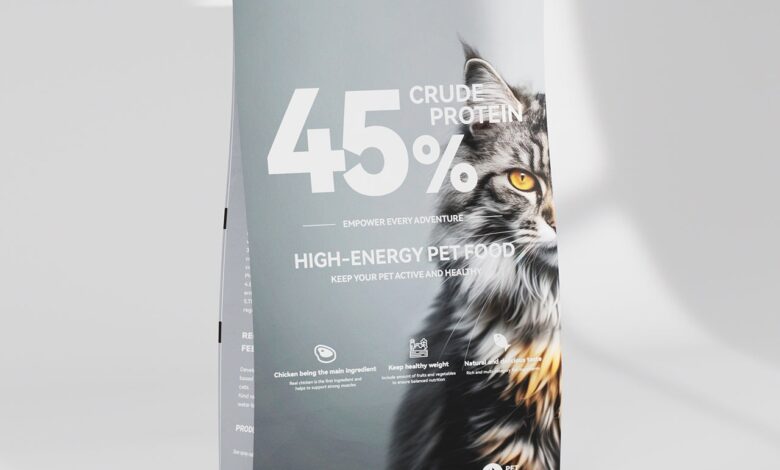5 High-Protein, High-Fat Cat Foods for Optimal Health

As a cat owner, you want nothing but the best for your feline companion, and nutrition plays a crucial role in their overall wellbeing. Cats are obligate carnivores, meaning their bodies are designed to thrive on diets rich in animal-based proteins and fats. Unlike humans or even dogs, cats have unique dietary requirements that demand careful attention to what goes into their food bowl each day.
Choosing the right high-protein, high-fat cat food can seem overwhelming with countless options lining pet store shelves. This guide is specifically designed for new cat owners who want to make informed decisions about their pet’s nutrition. We’ll explore why protein and fat matter so much for your cat’s health, examine five excellent food options that deliver these essential nutrients, and provide practical tips on selecting and serving the best diet for your furry friend. By understanding these fundamentals, you’ll be equipped to support your cat’s energy levels, maintain their ideal body condition, and promote long-term health through proper nutrition.
Understanding the Benefits of High-Protein and High-Fat Cat Food
Cats have evolved as strict carnivores with metabolic systems fundamentally different from omnivorous pets. Their bodies are specifically adapted to extract energy primarily from animal proteins and fats rather than carbohydrates. When you feed your cat a diet rich in these essential nutrients, you’re working with their natural biology rather than against it.
Protein serves as the building block for virtually every tissue in your cat’s body. It maintains lean muscle mass, supports immune function, and provides the amino acids cats cannot synthesize on their own, such as taurine and arginine. Without adequate protein, cats can develop serious health issues including heart disease, vision problems, and weakened immunity. The quality matters too—animal-based proteins contain the complete amino acid profile cats need, while plant proteins often fall short.
Fat plays an equally vital role in feline health. It provides concentrated energy that fuels your cat’s active lifestyle and supports their naturally fast metabolism. Dietary fats supply essential fatty acids like omega-3 and omega-6, which promote healthy skin and a lustrous coat. These nutrients also facilitate the absorption of fat-soluble vitamins A, D, E, and K, all crucial for various bodily functions. Additionally, fat makes food more palatable, encouraging proper eating habits and maintaining your cat’s interest in their meals.
When cats receive optimal levels of both protein and fat, you’ll notice tangible improvements in their overall condition. Their coat becomes shinier, their energy levels stabilize throughout the day, and they maintain healthy body weight more easily. These nutrients work synergistically to support everything from brain function to joint health, setting the foundation for a long, vibrant life.
See also: Why Your Pond Needs a Strong Pond Filter for Healthy Fish
Protein-Rich Cat Food Options
When searching for protein-rich cat food, your primary focus should be on formulas where animal protein appears as the first ingredient. Whole meats like chicken, turkey, salmon, or beef indicate quality sourcing. These foods typically contain 40% or higher protein content on a dry matter basis, providing the concentrated nutrition your cat’s body craves.
Grain-free formulas often deliver higher protein concentrations because they replace carbohydrate fillers with additional meat content. Look for foods that list multiple animal protein sources in the first five ingredients, as this variety ensures a comprehensive amino acid profile. Some premium brands incorporate organ meats like liver and heart, which are nutritional powerhouses packed with taurine and other essential nutrients cats need for heart and eye health.
Wet food varieties generally offer higher protein percentages than dry kibble when compared on a dry matter basis. The moisture content in canned or pouch formats doesn’t dilute the nutritional value—instead, these options provide hydration alongside protein. Many cats find wet food more palatable, making it easier to ensure they consume adequate protein daily. If your cat prefers dry food, consider mixing formats to balance convenience with optimal nutrition.
Limited ingredient formulas can be excellent high-protein choices, especially for cats with sensitivities. These foods focus on one or two primary protein sources without unnecessary additives, making them easier to digest while still delivering robust protein levels. They work particularly well for cats transitioning from lower-quality foods or those with suspected food intolerances.
Raw and freeze-dried options represent another category worth considering. These minimally processed foods preserve natural enzymes and nutrients that cooking can diminish. While they require careful handling and storage, many cat owners report noticeable improvements in their pets’ coat quality and energy levels. Freeze-dried formulas offer the nutritional benefits of raw feeding with greater convenience and longer shelf stability.
When evaluating protein-rich options, examine the guaranteed analysis panel on packaging. The crude protein percentage tells you the minimum protein content, but quality matters as much as quantity. Animal-based proteins should dominate the ingredient list, with minimal plant proteins like pea protein or potato protein. Your cat’s body utilizes animal proteins far more efficiently, converting them into the energy and tissue maintenance their carnivorous nature demands.
Age-specific formulas also deserve attention. Kittens require even higher protein levels to support rapid growth, while senior cats benefit from easily digestible protein sources that accommodate changing metabolic needs. Selecting age-appropriate high-protein food ensures your cat receives tailored nutrition throughout their life stages.
Fat-Rich Cat Food Options
High-fat cat foods provide the calorie-dense nutrition that supports your cat’s energy requirements and overall vitality. Quality fat sources should come from identified animal sources like chicken fat, salmon oil, or beef fat rather than generic terms like “animal fat.” These specific sources ensure your cat receives beneficial omega fatty acids alongside energy-rich calories.
Foods formulated for all life stages or specifically for active cats typically contain elevated fat levels, usually ranging from 18% to 25% or higher on a dry matter basis. This fat content mirrors what cats would naturally consume in the wild when eating whole prey. The concentrated energy helps maintain ideal body condition without requiring your cat to consume excessive food volumes, which is particularly beneficial for cats with smaller appetites.
Salmon-based formulas naturally provide higher omega-3 fatty acid content, supporting anti-inflammatory responses throughout your cat’s body. These essential fats contribute to joint health, cognitive function, and cardiovascular wellness. If your cat shows signs of dry skin, dull coat, or joint stiffness, increasing their intake of omega-3-rich foods can produce noticeable improvements within several weeks.
Pâté-style wet foods often contain higher fat percentages than other formats, creating a smooth, rich texture that appeals to even finicky eaters. The fat content enhances palatability while delivering sustained energy. These formulas work exceptionally well for underweight cats or those recovering from illness, as the calorie density helps restore healthy body condition without overwhelming their digestive system.
Foods supplemented with fish oil or flaxseed oil offer additional fat content beyond what the primary ingredients provide. While fish oil delivers ready-to-use omega-3s, cats can convert only small amounts of plant-based omega-3s from flaxseed into usable forms. Animal-based fat sources remain the most bioavailable option for feline nutrition, though some plant oils can provide supplementary benefits.
When selecting fat-rich options, balance is essential. While cats need substantial fat intake, excessive amounts can lead to digestive upset, especially during dietary transitions. Gradually introduce higher-fat foods over seven to ten days, mixing increasing proportions with your cat’s current food. This approach allows their digestive system to adapt to the richer nutritional profile without causing stomach discomfort or loose stools.
Premium kitten formulas naturally contain elevated fat levels to fuel growth and development, making them suitable for underweight adult cats needing to gain weight. The higher calorie concentration means smaller portions deliver adequate nutrition, which can benefit cats with reduced appetites. However, monitor body condition carefully to prevent overfeeding once your cat reaches their optimal weight.
Consider rotating between different high-fat protein sources to provide nutritional variety. Alternating between poultry-based, fish-based, and red meat options ensures your cat receives diverse fatty acid profiles and prevents boredom with their meals. This rotation strategy also reduces the risk of developing sensitivities to any single protein source over time.
How to Choose the Right High-Protein, High-Fat Cat Food
Selecting the ideal high-protein, high-fat cat food requires examining several key factors beyond just the protein and fat percentages. Start by reading the ingredient list carefully—the first three to five ingredients reveal the food’s true nutritional foundation. Animal proteins like chicken, turkey, salmon, or beef should dominate this list, with named fat sources appearing early as well. Avoid foods where grains, corn, or unidentified by-products occupy top positions, as these indicate lower nutritional quality that doesn’t align with your cat’s carnivorous needs.
Consider your cat’s individual circumstances when making your selection. Age significantly impacts nutritional requirements—kittens need higher protein and fat levels to fuel growth, adults require maintenance formulas that sustain energy and health, while seniors often benefit from highly digestible proteins that accommodate slower metabolism. Activity level also matters; indoor cats typically need fewer calories than outdoor cats, so adjust fat content accordingly to prevent unwanted weight gain. If your cat has existing health conditions like kidney disease or diabetes, consult your veterinarian before switching to high-protein or high-fat formulas, as certain conditions require modified nutritional approaches.
The guaranteed analysis panel provides essential nutritional data, but interpret these numbers correctly. Since moisture content varies dramatically between wet and dry foods, calculate dry matter basis percentages for accurate comparisons. Divide the nutrient percentage by the dry matter percentage (100 minus moisture content) to determine true protein and fat concentrations. This calculation reveals that many wet foods actually contain higher protein percentages than they initially appear, making them excellent choices despite seemingly lower crude protein numbers.
Feeding frequency and portion sizes depend on the food’s caloric density. High-fat foods pack more calories into smaller volumes, meaning your cat needs less food per serving compared to lower-fat options. Most quality cat foods provide feeding guidelines based on weight, but these serve as starting points rather than absolute rules. Monitor your cat’s body condition over several weeks, adjusting portions until you can feel their ribs with gentle pressure but not see them prominently. A visible waist when viewed from above indicates healthy weight maintenance. Split daily portions into two or three meals to prevent overeating and maintain steady energy levels throughout the day, which better mimics natural feline eating patterns.
Feeding Tips for Your High-Protein, High-Fat Cat
Transitioning your cat to a high-protein, high-fat diet requires patience and careful observation to ensure digestive comfort and acceptance. Introduce the new food gradually over seven to ten days, beginning with a ratio of 25% new food mixed with 75% current food. Every two to three days, increase the proportion of new food while decreasing the old, moving to 50-50, then 75-25, until you’ve completed the full transition. This methodical approach prevents digestive upset like vomiting or diarrhea that can occur when cats switch foods too abruptly, especially when moving to richer formulas with higher fat content.
Portion control becomes particularly important with calorie-dense, high-fat foods. Measure your cat’s food using a standard measuring cup rather than estimating, as even small overfeeding can lead to gradual weight gain over time. Divide the daily portion into two or three smaller meals rather than leaving food available all day. This feeding schedule prevents overeating, maintains consistent energy levels, and aligns with your cat’s natural hunting instincts to eat multiple small meals. If your cat tends to eat too quickly, consider using puzzle feeders or slow-feed bowls from retailers like PetCoolGo that encourage more deliberate eating and better digestion.
Hydration deserves special attention when feeding high-protein diets, as protein metabolism produces waste products that kidneys must filter. Ensure fresh water is always available in multiple locations throughout your home. Cats often prefer running water, so consider a cat water fountain to encourage increased drinking. If your cat primarily eats dry food, incorporating wet food into their diet provides additional moisture that supports kidney function and urinary tract health. Some cats drink more when water bowls are placed away from food dishes, as they instinctively prefer separating their water source from eating areas.
Supporting Your Cat’s Health Through Optimal Nutrition
Feeding your cat a high-protein, high-fat diet aligns with their biological needs as obligate carnivores, supporting everything from muscle maintenance and immune function to healthy skin and sustained energy levels. The right food features animal-based proteins as primary ingredients, with identified fat sources that deliver essential omega fatty acids. Quality matters as much as quantity—look for whole meats, organ inclusions, and minimal plant-based fillers when selecting formulas that will truly nourish your feline companion.
Choosing the appropriate food requires evaluating your cat’s age, activity level, and individual health status while carefully reading ingredient lists and calculating dry matter nutritional values. Transition gradually to prevent digestive upset, measure portions accurately to maintain ideal body condition, and ensure constant access to fresh water to support the increased metabolic demands of protein-rich diets. By implementing these feeding strategies, you create a nutritional foundation that promotes long-term health and vitality.
Your commitment to understanding and providing optimal nutrition demonstrates the care every cat deserves. With the knowledge you’ve gained about high-protein, high-fat foods and proper feeding practices, you’re well-equipped to make informed decisions that will help your cat thrive for years to come.




